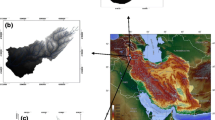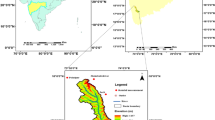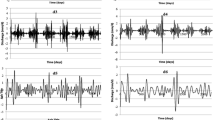Abstract
The existence of high uncertainty and nonlinearity of rainfall and runoff relationships makes it difficult to simulate the process. In this study, cross-wavelet transform, Kalman Filter, and Linear Programming methods (KF–LP–CW), and also a combination of cross-wavelet model and geomorphologic unit hydrograph (GIUH–CW) and GIUH based on Nash models (GIUH-Nash–CW) were used to analyze nine compound events of rainfall–runoff of the Sufi Chai watershed, Iran. In this study, by applying the phase difference between rainfall and runoff signals, effective rainfall hyetograph components were modified to minimize the simulation error which was added to model as pseudo-lag time (PLT). By applying cross-wavelet method phase differences, all of the errors in the simulation, such as loss of infiltration, evaporation, and human and instrument measurement errors, are included in the effective precipitation hyetograph and involve the displacement of the effective rainfall components. In this paper, the use of phase difference diagrams and its application in the simulation of compound events is discussed. Other applications of phase differences diagrams are being studied. The calculated unit hydrograph of the linear programming method was used as the Kalman filter measurement model. In addition, the convolutional integral as a transfer function was used in three methods. Using the four evaluation criteria, in terms of the Modified Nash–Sutcliff coefficient (Ej), the results showed that the KF–LP–CW method compared to the other three methods in both calibration steps (0.96) and Verification (0.82) is more suitable. In the case of time to peak estimation, the model performance was more successful than for the base time and peak discharge, respectively.














Similar content being viewed by others
References
Behrad Mehr N (2008) Portfolio allocation using wavelet transform. University of New York, Ph. D Thesis, pp 1–79
Chavan SR, Srinivas VV (2015) Effect of DEM source on equivalent Horton–Strahler ratio based GIUH for catchments in two Indian River basins. J Hydrol 528:463–489
Chen BH, Wang XZ, Yang SH, McGreavy C (1999) Application of wavelets and neural networks to diagnostic system development, 1, feature extraction. Comput Chem Eng Elsevier Sciences Ltd 23(7):899–906
Cheng H, Sun Z (1996) Application of wavelet packets theory in maneuver target tracking. In: Proceedings of the IEEE 1996 national aerospace and electronics conference, NAECON, 1:157–162
Chou CM, Wang RY (2004) Application of wavelet-based multimodel Kalman filters to real-time flood forecasting. Hydrol Process 18:987–1008
Chow VT, Maidment DR, Mays LW (1988) Applied hydrology. McGraw-Hill book company, New York
Du K, Zhao Y, Lei J (2017) The incorrect usage of singular spectral analysis and discrete wavelet transform in hybrid models to predict hydrological time series. J Hydrol 552:44–51
Grinsted A, Moore JC, Jevrejeva S (2004) Application of the cross wavelet transform and wavelet coherence to geophysical time series. Nonlinear Process Geophys 11:561–566
Guasti Lima F, Assaf Neto A (2012) Combining wavelet and kalman filters for financial time series forecasting. J Int Finan Econ 12(3):p47
Hong L, Chen G, Chui CK (1998) A filter-bank-based Kalman filtering technique for wavelet estimation and decomposition of random signals. IEEE Trans Circuits Syst-II 45(2):237–241
Horton RE (1945) Erosional development of streams and yheir drainage basins: hydrophysical approach to quantitative morphology. Geol Soc Am Bull 56(3):275–370
Hudgins L, Friehe CA, Mayer ME (1993) Wavelet transforms and atmospheric turbulence. Phys Rev Lett 71(20):3279–3282
Jury MR, Enfield DB, Melice JL (2002) Tropical monsoons around Africa: stability of El Nino-southern oscillation associations and links with continental climate. J Geophys Res 107:10
Kamruzzaman M (2014) Wavelet-based rainfall–stream flow models for the southeast Murray darling basin. J Hydrol Eng 19(7):1283–1293
Krause P, Boyle DP, Base F (2005) Comparison of different efficiency criteria for hydrological model assessment. Adv Geosci 5:89–97
Kumari Karunasingha DS, Liong Y (2018) Enhancement of chaotic hydrological time series prediction with real-time noise reduction using extended Kalman Filter. J Hydrol 565:737–746
Lee YH, Singh VP (1999) Tank model using Kalman filter. J Hydrol Eng 4:344–349
Liu Y, Brown J, Demargne J, Jun Seo D (2011) A wavelet-based approach to assessing timing errors in hydrologic predictions. J Hydrol 397:210–224
Marraun D, Kurths J (2004) Cross wavelet analysis: significance testing and pitfalls. Nonlinear Process Geophys 11:505–514
Mizumura K (1984) Aplication of Kalman filter to oceanic data. J Waterway Port Coast Ocean Eng 110:334–343
Nakken M (1999) Wavelet analysis of rainfall–runoff variability isolating climatic from anthropogenic patterns. Environ Model Softw 14:283–295
Nayak PC, Venkatesh B, Krishna B, Jain SK (2013) Rainfall-runoff modeling using conceptual, data driven, and wavelet based computing approach. J Hydrol 493:57–67
Nourani V, Hosseini Baghanam A, Adamowski J, Kisi O (2014) Applications of hybrid wavelet artificial intelligence models in hydrology: A review. J Hydrol 517:19–1189
Papadakis C, Kazan N (1986) Time of concentration in small rural watersheds. Technical report 101/08/86/CEE. College of Engineering, University of Cincinnati. Cincinnati, OH
Rodriguez-Iturbe I, Valdes JB (1979) The geomorphic structure of hydrologic response. Water Resour Res 18(4):877–886
Rosso R (1984) Nash model relation to Horton order ratios. Water Resour Res 20:914–920
Sahoo R, Jain V (2018) Sensitivity of drainage morphometry based hydrological response (GIUH) of a river basin to the spatial resolution of DEM data. Comput Geosci 111:78–86
Shoaib M, Shamseldin Y, Melville AW (2014) Comparative study of different wavelet based neural network models for rainfall-runoff modeling. J Hydrol 515:47–58
Tejaswini NB, Hegde SA, V.S (2011) Spatial variation in drainage characteristics and geomorphic instantaneous unit hydrograph (GIUH); implications for watershed management—a case study of the Varada River basin, Northern Karnataka. Catena 87:52–59
Theil H (1967) Economics and information theory. North Holland, Amesterdam
Todini E (1978) Mutually interactive state parameter (MISP) estimation. Application of Kalman filter, Proc., AGU Chapman Conf., University of Pittsburgh, Pittsburgh: 135–151
Torrence C, Compo GP (1998) A practical guide to wavelet analysis. Bulletin of the American eteorological Society. Bull Am Meteor Soc 79(1):61–78
Wu CM, Huang WC (1990) Effect of observability in Kalman filtering on rainfall-runoff modeling. Taiwan Water Conserv Q 38:37–47
Author information
Authors and Affiliations
Corresponding author
Additional information
Publisher’s Note
Springer Nature remains neutral with regard to jurisdictional claims in published maps and institutional affiliations.
Rights and permissions
About this article
Cite this article
Mohammadi, F., Fakheri Fard, A. & Ghorbani, M.A. Application of cross-wavelet–linear programming–Kalman filter and GIUH methods in rainfall–runoff modeling. Environ Earth Sci 78, 168 (2019). https://doi.org/10.1007/s12665-019-8133-3
Received:
Accepted:
Published:
DOI: https://doi.org/10.1007/s12665-019-8133-3




